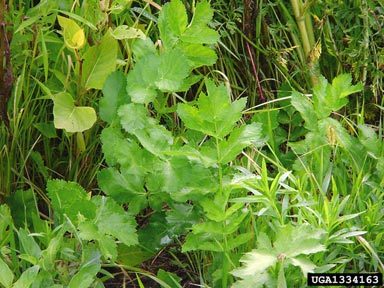
Identification:
Appearance: Monocarpic perennial herbaceous plant (plant spends one or more years in rosette stage, blooms under favorable conditions, and then dies), 6″ high in the rosette stage and 4′ high on stout, grooved stems in the flowering stage.
Leaves: Alternate, leaf is made up of 5 -15 egg shaped leaflets along both sides of a common stalk; leaflets sharply-toothed or lobed at the margins; upper leaves smaller.
Flowers: Flat-topped broad flower cluster 2 – 6″ wide, individual flowers are tiny with five petals; bloom from June to late summer.

Seeds: Small, flat, round, slightly ribbed, straw-colored, abundant take 3 weeks to ripen before they can reseed; viable in the soil for 4 years.
Roots: Long, thick, edible taproot.
Similar plants:
The prairie plant golden alexander (Zizia aurea) is easily mistaken for Wild Parsnip, especially when both plants are small. Except in very small specimens golden alexander is much less robust than wild parsnip. The most distinct difference between the two are the leaves; wild parsnip has deeply forked leaves and those of golden alexander are overall smooth with fine serrations. Also, the flowers of wild parsnip form a flat cluster, golden alexander’s are much more loosely and unevenly clustered.

Reasons Wild Parsnip is a problem:
- Wild parsnip readily moves into disturbed habitats, along edges and or in disturbed patches.
- Wild parsnip invades slowly, but once populations build it spreads rapidly and can severely modify open dry, moist, and wet-moist habitats, soon dominating areas.
- Wild parsnip grows very rapidly and is persistent, even after being sprayed.
- Contact with the sap of wild parsnip combined with the presence of sunlight causes phytophotodermatitis, very unpleasant rashes on skin, making this plant difficult to remove by hand. The rash is similar to a severe burn and may take many weeks to heal, leaving long lasting scars.
Other Info:
A native of Europe and Asia, wild parsnip has escaped from cultivation in the United States. It is tolerant of a wide range of conditions, including dry, mesic, and wet-mesic prairies; oak openings; and calcareous fens, and is primarily a problem in southern Minnesota in prairies and oak openings. It is shade-intolerant, however, preferring sunny conditions, and as conditions for wild parsnip growth become more optimal seed production increases greatly. Because of wild parsnip’s success in prairies and oak savannas it is a target species for eradication in the Cowling Arboretum.
Wild parsnip has only begun showing up in large numbers in the Arboretum in the past few years, and these plants have been the subject of mowing and spraying. To this point, the spread of wild parsnip has been mostly confined to the roadside ditch on Highway 19, Hillside Prairie and the southern portions of the newly planted ’06 and ’04 prairie fields. It is hoped that with consistent control with herbicides, mowing and digging, the populations can be eliminated or at least controlled.
Cowling Arboretum Procedures for Removal:
Control of wild parsnip can be done by hand if the infestation is small. Plants can be pulled if the ground is wet, or the tap root of each plant can be cut with a sharp-bladed shovel. In dense populations herbicide application is used. Areas of heavy infestation are mowed with follow up herbicide or hand cutting or pulling of stray plants. Staff or volunteers doing this work must avoid all skin contact with the plant so protective clothing is a must.